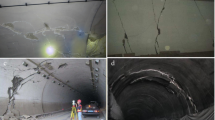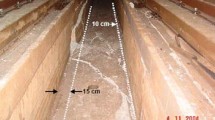Abstract
A total of 81 mountain tunnels that were damaged in 10 strong earthquakes are studied. They are classified into six typical damage characteristics: lining cracks, shear failure of lining, tunnel collapse caused by slope failure, portal cracking, leaking, and deformation of sidewall/invert damage. Further study and discussion are carried out on influencing factors for mountain tunnels, including seismic parameters, structural information, and rock conditions. Suggestions are also made regarding seismic resistance and reduction.












Similar content being viewed by others
References
Chen ZY, Wang CH (2011) Design and exploitation of damage database under earthquake for underground structure in VB. (Submitted to Rock and Soil Mechanics)
Chen GH, Li HQ, Zhong Y, Li YS (2008) Investigation and analysis on damage of state road 213 Dujiang Dam to Wenchuan. Southwest Road (4):114–119 (in Chinese)
Dowding CH, Rozen A (1978) Damage to rock tunnels from earthquake shaking. J Geotech Eng Div ASCE 104(GT2):175–191
Duke CM, Leeds DJ (1959) Effects of earthquakes on tunnels, protective construction in a nuclear age, vol 1. In: Proceedings of the second protective construction symposium, 24–26 March, pp 303–328
Gong ZH (2007) Study on the seismic safety evaluation of Huangcaoping Tunnel of National Road No. 318. Dissertation, Chengdu University of Technology (in Chinese)
International Tunneling Association Working Group on Maintenance and Repair of Underground Structures (1991) Report on the damaging effects of water on tunnels during their working life. Tunn Undergr Space Technol 6(1):11–76
Li YS (2006) Study on earthquake responses and vibration-absorption measures for mountain tunnel. Dissertation, Tongji University (in Chinese)
Li TB (2008) Failure characteristics and influence factor analysis of mountain tunnels at epicenter zones of great Wenchuan Earthquake. Journal of Engineering Geology 16(6):742–750 (in Chinese)
Luo WH (1989) Overview of underground structure damage under earthquake of home and aboard. Tunn Undergr Space Eng 10(3):61–65
Pan SC (1996) Review on anti-seismic problems on tunnels and underground structures. World Tunn (5):7–16 (in Chinese)
Power MS, Rosidi D, Kaneshiro, JY (1998) Seismic vulnerability of tunnels and underground structures revisited. In: Ozedimir L (ed) Proceedings of the North American Tunneling’98, Balkema, Rotterdam, pp 243–250
Rowe R (1992) Tunneling in seismic zones. Tunn Tunn 24(12):41–44
Sharma S, Judd WR (1991) Underground opening damage from earthquakes. Eng Geol 30:263–276
Shen YS, Gao B, Wang ZZ, Wang XY (2008) Model test for a road tunnel in the region of high seismic intensity. Mod Tunn Technol 45(5):38–42 (in Chinese)
Shen YS, Gao B, Wang XY (2009) Structural dynamic properties analysis for portal part of mountain tunnel in strong earthquake area. Chin J Rock Mech Eng 28(1):3131–3136 (in Chinese)
Shimizu M, Suzuki T, Kato S et al. (2007) Historical damages of tunnels in Japan and case studies of damaged railway tunnels in the Mid Niigata prefecture earthquakes. Underground space—the 4th dimension of metropolises, pp 1937–1943
Shunzo O (1984) Introduction to earthquake engineering, 2nd edn. University of Tokyo Press, Tokyo
Wang WL, Wang TT, Su JJ, Lin CH, Seng CR, Huang CH (2001) Assessment of damage in mountain tunnels due to the Taiwan Chi-Chi Earthquake. Tunn Undergr Space Technol 16(3):133–150
Wang XY, Liu WN, Zhang M (2003) Study on the categorization and mechanism of seismic damage of underground structures. China Saf Sci J 13(11):55–58 (in Chinese)
Xiao LG (2000) Causes, law and prevention of underground structure destruction. Dissertation, Southwest Jiaotong University (in Chinese)
Yakovlevich DI, Borisovna MJ (1978) Behavior of tunnel liner model on seismic platform. VI Sump on Earthquake Engineering, University of Roorkee, Roorkee, pp 379–382
Yan XS, Zhu HH, Wang YC (2009) Several characteristics of seismic response of mountain-crossing tunnels. Tunn Constr 29(4):420–423 (in Chinese)
Acknowledgments
This research was supported by the National Natural Science Foundation of China (Grant No. 50908169), State Key Laboratory of Geo-Hazard Prevention and Geo-Environment Protection (Grant No. SKLGP2011K009), Program for Changjiang Scholars and Innovative Research Team in University (PCSIRT, IRT1029), and the Kwang-Hua Fund for College of Civil Engineering, Tongji University. All supports are gratefully acknowledged.
Author information
Authors and Affiliations
Corresponding author
Rights and permissions
About this article
Cite this article
Chen, Z., Shi, C., Li, T. et al. Damage characteristics and influence factors of mountain tunnels under strong earthquakes. Nat Hazards 61, 387–401 (2012). https://doi.org/10.1007/s11069-011-9924-3
Received:
Accepted:
Published:
Issue Date:
DOI: https://doi.org/10.1007/s11069-011-9924-3




